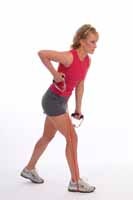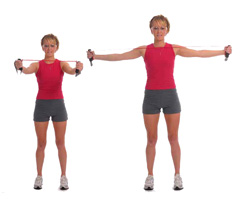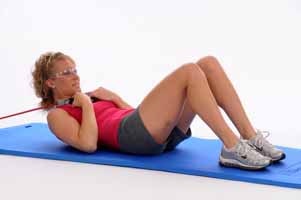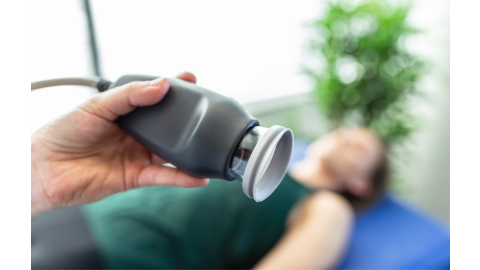All tennis players want a great serve. It can win you the point. But many players don’t know what to focus on to improve their serve’s power and velocity.
Tennis requires quick legs to get to the ball and several muscles from your legs to your hips to your shoulder to your arm when serving. Your main goal should be strengthening these muscles to improve your serve and keep you in the game without shoulder injuries or tennis elbow pain.
Ready to start? All you need is a TheraBand CLX Resistance Band and a desire to improve!
The Research-Proven Solution to Improve Your Serve: Elastic Resistance

Improve Your Performance with Resistance Tubing
Title: Effects of a 6-Week Junior Tennis Conditioning Program on Service Velocity
Participants: 30 nationally ranked male junior tennis players
Study: The players were randomly assigned into either the exercise group or control group. The exercise group performed one hour of conditioning exercises three days a week. The exercises consisted of a ten minute warmup and a fifty minute strength training session (core exercises, TheraBand tubing exercises, and medicine ball throws).
Results: The exercise group significantly increased their serve velocity with an average of 4.9%, while the control group did not improve their velocity. Both groups improved their shoulder range of motion. Additionally, neither group had a significant change in their serve accuracy.
The Top 7 Resistance Band Exercises for Tennis Players
For these exercises you can use TheraBand Resistance Tubing or TheraBand CLX Resistance Bands. The goal is endurance, so you don’t need a high level of resistance.
|
1. TheraBand Wrist Flexion/Extension


- This exercise can be performed while sitting on a chair/exercise ball.
- Step on the middle of the tubing with one foot, securing it in place.
- Grasp the handle with your palm facing the floor while resting your forearm on your thigh.
- Slowly extend your wrist upward, hold, and return.
- Repeat for two sets of twenty repetitions.
- Switch your grip so your palm is facing upward.
- Repeat the exercise for two more sets.
2. TheraBand Row

- Stand in a staggered stance with your front foot on the middle of the tubing.
- Bend forward at the hips without arching your back.
- Grasp one end of the tubing in each hand with your elbows extended.
- Pull one end of the tubing upward bending your elbow in a rowing motion.
- Hold then slowly return, don’t rotate your trunk.
- Repeat using the opposite arm.
- Complete two sets of twenty repetitions on each side.
3. TheraBand Shoulder External Rotation

- Secure one end of the tubing to a study attachment point (a door anchor works great).
- Roll up a towel and place it under your upper arm, bending your elbow so your forearm is in front of your body.
- Hold the handle and pull outward, keeping your elbow at your side and your forearm parallel to the floor.
- Hold, slowly return, and repeat for two sets of twenty reps.
4. TheraBand Shoulder Dynamic Hug

- Wrap the tubing around your upper back, holding one handle in each hand.
- Bring the ends together and cross your forearms, with straight wrists and bent elbows.
- Hold, return, and repeat for two sets of twenty repetitions.
5. TheraBand Reverse Fly

- Hold one end of the tubing in each hand at shoulder level.
- Extend your arms outward, stretching the tubing, with your arms still at shoulder height.
- Slowly return, keeping your trunk upright.
- Repeat for two sets of twenty reps.
The previous exercises focused on your arms, especially your shoulders. These are crucial muscles for serving. But you know a good serve starts in the legs, hips, and core and follows through to the arm, which is why the last two exercises focus on the rest of your body.
6. TheraBand Supine Abdominal Crunch

- Secure the middle of the tubing at floor level near your head.
- Hold one handle in each hand.
- Pull the tubing away from the anchor point as you complete a crunch, lifting your trunk forward.
- Hold and repeat, keeping your feet flat on the floor.
7. TheraBand Lunge

- Stand with one foot on the middle of the tubing.
- Hold one handle in each hand at chest level with your elbows bent.
- Place your other leg behind you with the knee slightly bent.
- Bend your knees so your front leg’s thigh and back leg’s shin are parallel to the floor.
- Keep your trunk upright and your back straight as you return to your starting position.
- Repeat.
These exercises will help you improve your serve and become a better tennis player! If your shoulder is currently overused, check out these shoulder rehabilitation exercises to get you back on the court.
References
Fernandez-Fernandez J, et al. Effects of a 6-week junior tennis conditioning program on service velocity. J Sports Sci Med. 2013. 12:232-239. Retrieved from https://bit.ly/2A1HV0H
Medical Disclaimer: The information provided on this site, including text, graphics, images and other material, are for informational purposes only and are not intended to substitute for professional medical advice, diagnosis or treatment. Always seek the advice of your physician or other healthcare professional with any questions or concerns you may have regarding your condition.








 France
France Australia
Australia






